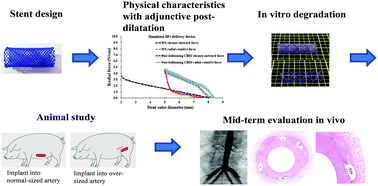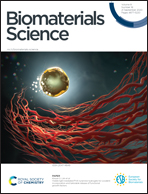Oversized composite braided biodegradable stents with post-dilatation for pediatric applications: mid-term results of a porcine study†
Abstract
Our aim was to apply a composite braided biodegradable stent (CBBS) made from poly p-dioxanone (PPDO) and polycaprolactone (PCL) as an alternative to metallic stents for the treatment of pediatric endovascular disease. CBBS properties after adjunctive post-dilatation were assessed using radial force testing. CBBS degradation was assessed using in vitro measurements. Self-expandable CBBSs (8 × 20 mm) were implanted in abdominal aortas with an oversizing ratio of 1.1–1.4 (group A, n = 12) and in common iliac arteries with an oversizing ratio >1.4 (group B, n = 12). Self-expandable metal WALLSTENTs (8 × 21 mm) were implanted in common iliac arteries with an oversizing ratio >1.4 and served as controls (group C, n = 12). Artery evaluations including angiography and histological examinations were performed at 1, 4, 6 and 12 months after stent implantation. Eight millimeter CBBSs delivered in 8Fr sheaths with adjunctive post-dilatation had properties similar to those of metallic benchmark stents and were degraded in 12 months, with mild to moderate inflammation-induced neointimal hyperplasia and vessel restenosis. Post-dilatation and oversizing are suggested when using CBBSs for polymeric strut tissue embedding and optimal wall apposition, but an overextended ratio should be avoided because of the induction of less-desirable neointimal hyperplasia. Mid-term outcomes of CBBSs with adjunctive post-dilatation were better than those of WALLSTENTs in a swine endovascular disease model.



 Please wait while we load your content...
Please wait while we load your content...